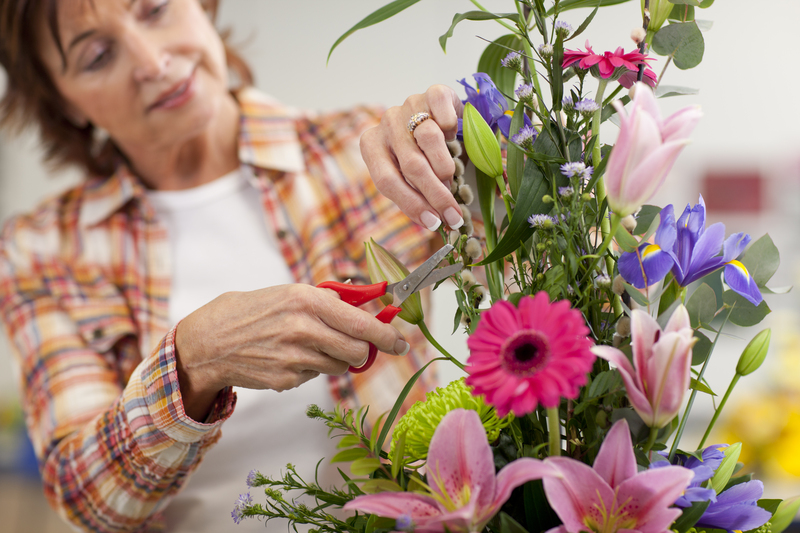Transforming Your Garden with Well-Cared-For Hydrangeas
Posted on 14/08/2025
Transforming Your Garden with Well-Cared-For Hydrangeas
Hydrangeas are renowned for their dazzling blooms and lush foliage. When well-cared-for, these stunning shrubs can dramatically transform your garden into a vibrant oasis of color and texture. Whether you are a novice gardener or an experienced horticulturalist, learning the secrets of hydrangea care will ensure that your landscape is filled with beautiful, healthy hydrangea flowers year after year. In this comprehensive guide, discover how transforming your garden with hydrangeas can enhance your outdoor space and provide year-round appeal.
Why Choose Hydrangeas for Garden Transformation?
Hydrangeas are versatile and eye-catching shrubs that suit a range of garden styles, from classic cottage gardens to contemporary landscapes. Here's why hydrangeas stand out when it comes to revamping your garden:
- Vibrant Color Variety: Hydrangeas offer a palette of colors, including blue, pink, white, purple, and even green hues.
- Extended Bloom Period: Many varieties bloom from late spring through autumn, ensuring long-lasting beauty.
- Adaptability: They thrive in both sun and partial shade, adapting to a variety of soil types.
- Structural Interest: Hydrangea bushes add volume and texture, making borders, beds, or standalone features pop.
Well-cared-for hydrangeas not only enhance curb appeal but also attract pollinators, provide privacy, and add seasonal interest with their changing colors. If you've been searching for a way to transform your outdoor living space, hydrangeas are an ideal choice.

Understanding Different Hydrangea Varieties
Before planting, it's vital to understand the different types of hydrangeas and how each one can play a unique role in your garden design:
Bigleaf Hydrangea (Hydrangea macrophylla)
- Known for large, round clusters of blooms.
- Flower color can change from pink to blue depending on soil pH.
- Perfect for bold, colorful displays.
Panicle Hydrangea (Hydrangea paniculata)
- Features cone-shaped flower clusters.
- Extremely hardy and thrives in colder climates.
- Blooms range from white to pink to deep red as the season advances.
Oakleaf Hydrangea (Hydrangea quercifolia)
- Unique oak-shaped leaves that turn fiery in autumn.
- Long-lasting white blooms that age to pink or red.
- Excellent for naturalistic or woodland gardens.
Smooth Hydrangea (Hydrangea arborescens)
- Known for robust, round white blooms.
- Popular variety includes the classic 'Annabelle' hydrangea.
- Best for shaded spots or naturalized areas.
Choosing the right variety is your first step in transforming your garden with hydrangeas that will thrive in your specific conditions.
Site Selection and Soil Preparation
One of the most crucial steps in cultivating healthy hydrangea plants is choosing the proper location and readying the soil. Here are some key considerations for optimal plant health:
- Light Requirements: Hydrangeas generally prefer morning sun with afternoon shade. Panicle hydrangeas can tolerate more sun, while bigleaf varieties do better with filtered light.
- Soil Quality: These shrubs thrive in rich, well-draining soil. Amend your soil with compost to boost fertility and drainage.
- pH Levels: The pH of your soil can impact flower color; acidic soils (lower pH) encourage blue blooms, while alkaline soils (higher pH) foster pink flowers.
- Space: Leave adequate space between plants to promote air circulation and reduce the risk of disease.
By taking the time to properly prepare your planting site, you lay the groundwork for lush, thriving hydrangea shrubs that will become the focal point of your garden transformation.
Planting Your Hydrangeas
For optimal growth and blooming, it's important to plant hydrangeas during the right time and with the proper technique. Follow these steps for successful planting:
- Plant in early spring or fall: The cool weather helps minimize stress and encourages strong root development.
- Dig a wide hole: The planting hole should be twice as wide as the root ball and just as deep.
- Loosen roots: Gently tease roots before planting to encourage them to spread outward.
- Backfill with amended soil: Mix compost or well-rotted manure into your backfill for a nutrient boost.
- Water thoroughly: Saturate the planting area to settle the soil and eliminate air pockets.
Pro Tip: Consider applying a layer of mulch after planting to conserve moisture, suppress weeds, and maintain soil temperature--a key factor in well-cared-for hydrangea gardens.
Essential Hydrangea Care Tips for a Stunning Garden
Once established, hydrangeas require consistent care and attention to reach their full potential. Here's how to ensure your hydrangea garden transformation is a long-term success:
1. Watering
- Hydrangeas need consistent moisture, especially in the first few years after planting.
- Deep, infrequent watering is better than shallow, frequent watering--aim for at least 1 inch of water per week.
- In hot climates, check soil moisture regularly to prevent wilting and leaf scorch.
2. Feeding and Fertilizing
- Apply a balanced, slow-release fertilizer in spring, just as new growth emerges.
- For vibrant blooms, supplement with an extra dose of phosphorus (like bone meal), especially for bigleaf hydrangeas.
- Refrain from over-fertilizing as it can lead to lush foliage at the expense of flowers.
3. Mulching
- A 2-3 inch layer of organic mulch conserves moisture, suppresses weeds, and keeps roots cool.
- Use bark, wood chips, pine needles, or compost as mulch materials.
4. Pruning for Shape and Blossoms
Proper pruning is essential for maintaining shape and encouraging abundant flowers in your transformed hydrangea garden:
- Prune bigleaf and oakleaf hydrangeas after blooming, as they set buds in the previous year.
- Panicle and smooth hydrangeas bloom on new wood--prune in late winter or early spring.
- Remove dead or damaged wood at any time to keep shrubs healthy.
5. Troubleshooting Common Hydrangea Problems
To maintain healthy, well-cared-for hydrangea plants, watch for these issues:
- Wilting or drooping: Usually a sign of underwatering or heat stress.
- Yellowing leaves: Can indicate poor drainage, overwatering, or nutrient deficiencies.
- Pests and diseases: Aphids, spider mites, powdery mildew, and leaf spot can affect hydrangeas. Use organic treatments and ensure proper air circulation.
Design Ideas for a Hydrangea-Transformed Garden
Transforming your garden with hydrangeas isn't just about planting these shrubs--it's about creating an integrated design that highlights their beauty all season long. Consider the following landscape tips:
1. Create Stunning Borders
- Line pathways, driveways, or property lines with hydrangeas for dramatic, flower-filled borders.
- Mix and match different hydrangea varieties for varied heights, colors, and textures.
2. Mix with Complementary Plants
- Combine with shade-loving perennials, such as hostas, ferns, or astilbes for a lush underplanting.
- Intermingle with ornamental grasses for contrasting form and movement.
3. Use as Focal Points or Hedges
- Plant a single large hydrangea as a show-stopping feature in a prominent garden bed.
- Mass plantings of hydrangeas create living screens or privacy hedges, especially along property boundaries.
4. Create Four-Season Interest
- Choose hydrangea varieties with stunning autumn foliage or exfoliating bark for winter appeal.
- Leave dried flower heads on the plants over winter for added texture and habitat for wildlife.
Strategic landscaping with hydrangeas can turn a plain yard into a multi-seasonal retreat, providing visual stimulus and inviting spaces to relax and entertain.
Changing Hydrangea Bloom Colors: Soil Tricks
One of the most unique features of hydrangeas--particularly bigleaf varieties--is the ability to change bloom color by altering the soil pH:
- To Encourage Blue Flowers: Add elemental sulfur, peat moss, or aluminum sulfate to the soil to lower pH to 5.2-5.5.
- To Promote Pink Flowers: Raise soil pH to 6.0-6.2 by adding lime or dolomitic limestone.
- Test Soil Regularly: Use a home soil testing kit to monitor pH changes and adjust amendments accordingly.
Note: White hydrangea varieties do not change color based on soil pH but benefit from similar soil conditions.
Propagating Hydrangeas for Continuous Garden Enhancement
If you wish to expand your hydrangea collection or share these lovely plants with friends, propagation is a rewarding technique:
Propagation via Cuttings
- Take softwood cuttings from new growth in late spring or early summer.
- Dip cut ends in rooting hormone and plant in a moist, well-draining propagation mix.
- Cover with a plastic dome or bag to maintain humidity until roots develop.
Layering
- Bend a low-growing branch to the ground and cover a section with soil, leaving the tip exposed.
- Roots will form along the buried stem--after several months, cut and transplant the new plant.
Propagation is a cost-effective way to enjoy more well-cared-for hydrangeas and maintain a magnificent, blossoming garden year after year.
Seasonal Hydrangea Maintenance Calendar
Care tasks change throughout the year as hydrangeas move from dormancy to flowering and back again. Keep your hydrangeas healthy with this simple seasonal checklist:
- Early Spring: Remove winter mulch, prune if needed, fertilize, and check soil moisture.
- Late Spring to Summer: Water regularly in dry spells, apply mulch, deadhead spent flowers, and monitor for pests.
- Autumn: Enjoy fall foliage, reduce watering as plants go dormant, and add a protective mulch layer before the first frost.
- Winter: Hydrangeas typically don't require much attention; just ensure roots are insulated in colder regions.

Common Hydrangea Questions Answered
As you embark on transforming your garden with well-cared-for hydrangeas, you may encounter a few questions:
Are hydrangeas high maintenance plants?
No. With proper siting and regular watering, hydrangeas are relatively easy to care for and reward you with long-lasting beauty.
Can hydrangeas survive in pots?
Yes! Choose compact varieties and ensure pots have good drainage. Regular watering and feeding are essential for container-grown hydrangeas.
Why aren't my hydrangeas blooming?
This is often due to improper pruning, insufficient sunlight, or late spring frosts damaging flower buds. Review the specific requirements for your hydrangea variety.
How often should I prune hydrangeas?
It depends on the variety. Prune old wood bloomers after flowering and new wood bloomers in late winter or early spring. Always remove dead or damaged stems anytime.
Conclusion: Your Garden's Transformation Awaits
Few plants can match the impact and versatility of well-cared-for hydrangeas in garden transformation. With countless varieties, enchanting flower colors, and adaptable habits, hydrangeas truly earn their place as favorite garden shrubs. By carefully selecting varieties, providing the right conditions, and following essential care practices, your garden can be reborn as a lush, flowering paradise that brings joy season after season.
Make this the year you begin transforming your garden with hydrangeas. With a little attention and the right knowledge, you'll enjoy dazzling displays and healthy plants that are the envy of the neighborhood. Happy gardening!
Latest Posts
Breathtaking Blooms That Last: Our Top 12 List
Your Birth Flower: A Petal-Perfect Insight Into Who You Are
Preserve Your Flower's Appeal with These 3 Easy Methods







